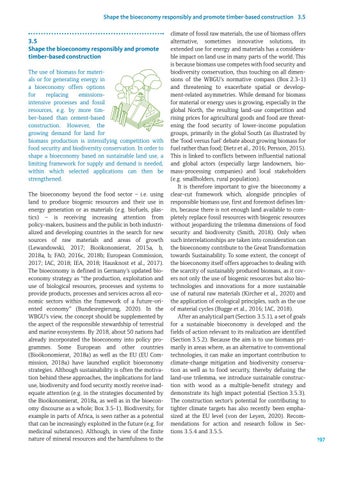Shape the bioeconomy responsibly and promote timber-based construction 3.5
3.5 Shape the bioeconomy responsibly and promote timber-based construction The use of biomass for materials or for generating energy in a bioeconomy offers options for replacing emissions- intensive processes and fossil resources, e.g. by more timber-based than cement-based construction. However, the growing demand for land for biomass production is intensifying competition with food security and biodiversity conservation. In order to shape a bioeconomy based on sustainable land use, a limiting framework for supply and demand is needed, within which selected applications can then be strengthened. The bioeconomy beyond the food sector – i.e. using land to produce biogenic resources and their use in energy generation or as materials (e.g. biofuels, plastics) – is receiving increasing attention from policy-makers, business and the public in both industrialized and developing countries in the search for new sources of raw materials and areas of growth (Lewandowski, 2017; Bioökonomierat, 2015a, b, 2018a, b; FAO, 2016c, 2018b; European Commission, 2017; IAC, 2018; IEA, 2018; Hausknost et al., 2017). The bioeconomy is defined in Germany’s updated bioeconomy strategy as “the production, exploitation and use of biological resources, processes and systems to provide products, processes and services across all economic sectors within the framework of a future-oriented economy” (Bundesregierung, 2020). In the WBGU’s view, the concept should be supplemented by the aspect of the responsible stewardship of terrestrial and marine ecosystems. By 2018, about 50 nations had already incorporated the bioeconomy into policy programmes. Some European and other countries (Bioökonomierat, 2018a) as well as the EU (EU Commission, 2018a) have launched explicit bioeconomy strategies. Although sustainability is often the motivation behind these approaches, the implications for land use, biodiversity and food security mostly receive inadequate attention (e.g. in the strategies documented by the Bioökonomierat, 2018a, as well as in the bioeconomy discourse as a whole; Box 3.5-1). Biodiversity, for example in parts of Africa, is seen rather as a potential that can be increasingly exploited in the future (e.g. for medicinal substances). Although, in view of the finite nature of mineral resources and the harmfulness to the
climate of fossil raw materials, the use of biomass offers alternative, sometimes innovative solutions, its extended use for energy and materials has a considerable impact on land use in many parts of the world. This is because biomass use competes with food security and biodiversity conservation, thus touching on all dimensions of the WBGU’s normative compass (Box 2.3-1) and threatening to exacerbate spatial or development-related asymmetries. While demand for biomass for material or energy uses is growing, especially in the global North, the resulting land-use competition and rising prices for agricultural goods and food are threatening the food security of lower-income population groups, primarily in the global South (as illustrated by the ‘food versus fuel’ debate about growing biomass for fuel rather than food; Dietz et al., 2016; Persson, 2015). This is linked to conflicts between influential national and global actors (especially large landowners, biomass-processing companies) and local stakeholders (e.g. smallholders, rural population). It is therefore important to give the bioeconomy a clear-cut framework which, alongside principles of responsible biomass use, first and foremost defines limits, because there is not enough land available to completely replace fossil resources with biogenic resources without jeopardizing the trilemma dimensions of food security and biodiversity (Smith, 2018). Only when such interrelationships are taken into consideration can the bioeconomy contribute to the Great Transformation towards Sustainability. To some extent, the concept of the bioeconomy itself offers approaches to dealing with the scarcity of sustainably produced biomass, as it covers not only the use of biogenic resources but also biotechnologies and innovations for a more sustainable use of natural raw materials (Kircher et al., 2020) and the application of ecological principles, such as the use of material cycles (Bugge et al., 2016; IAC, 2018). After an analytical part (Section 3.5.1), a set of goals for a sustainable bioeconomy is developed and the fields of action relevant to its realization are identified (Section 3.5.2). Because the aim is to use biomass primarily in areas where, as an alternative to conventional technologies, it can make an important contribution to climate-change mitigation and biodiversity conservation as well as to food security, thereby defusing the land-use trilemma, we introduce sustainable construction with wood as a multiple-benefit strategy and demonstrate its high impact potential (Section 3.5.3). The construction sector’s potential for contributing to tighter climate targets has also recently been emphasized at the EU level (von der Leyen, 2020). Recommendations for action and research follow in Sections 3.5.4 and 3.5.5. 197
